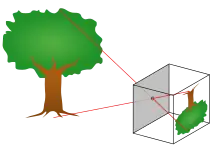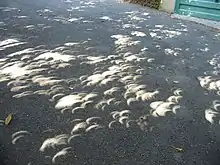Pinhole camera
A pinhole camera is a camera without a conventional glass lens. An extremely small hole in a thin material can create an image when all light rays from a scene go through a single point. In order to produce a reasonably clear image, the aperture has to be about 1/100th the distance to the screen, or less. The shutter of a pinhole camera usually consists of a hand operated flap of some light-proof material to cover and uncover the pinhole.


A common use of a pinhole camera is to capture the movement of sunlight over a long period of time. This type of photography is called Solargraphy. Pinhole cameras require much longer exposure times than conventional cameras because of the small aperture; typical exposure times can range from 5 seconds to hours or days.
The image may be projected on a translucent screen for real-time viewing (popular for viewing solar eclipses; see also camera obscura).
Like other cameras, pinhole cameras make the picture upside-down.
Invention of pinhole camera
Very early in history (as far back as 500 B.C.), Greeks such as Aristotle and Euclid wrote on naturally-occurring rudimentary pinhole cameras, for example light may travel through the slits of wicker baskets and the crossing of leaves [1] The ancient Greeks, however, believed that our eye emitted rays which enabled us to see. What enabled a much better understanding of the pinhole camera was the discovery that light enters the eye rather than leaving it. It was the 10th-century Muslim mathematician, astronomer and physicist Ibn al-Haytham who published this idea.
Notes and references
- "Light Through the Ages" Archived 2016-03-03 at the Wayback Machine.